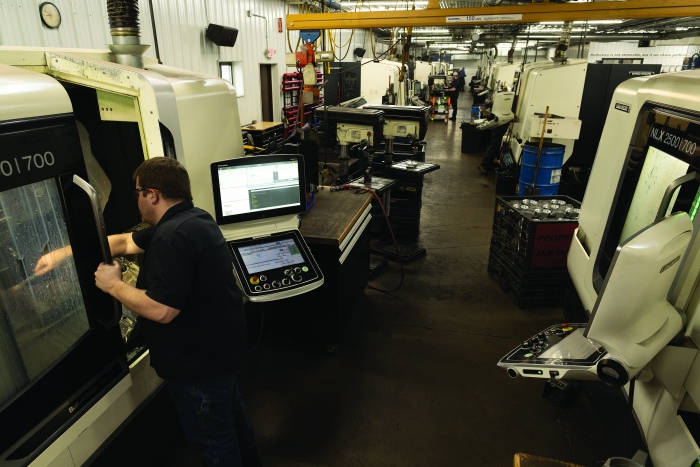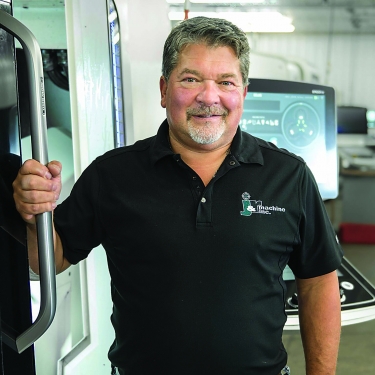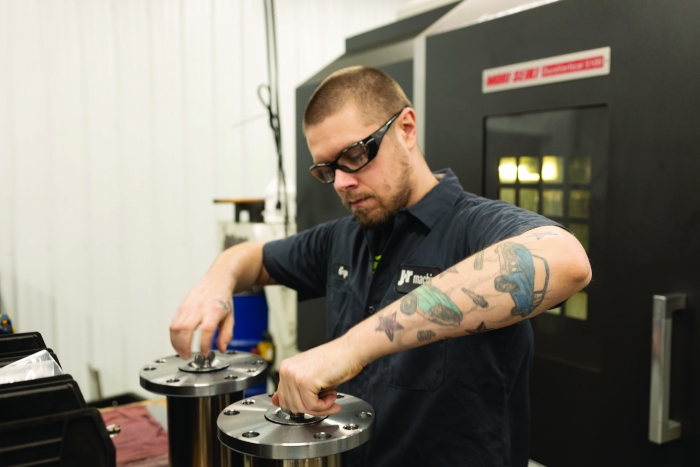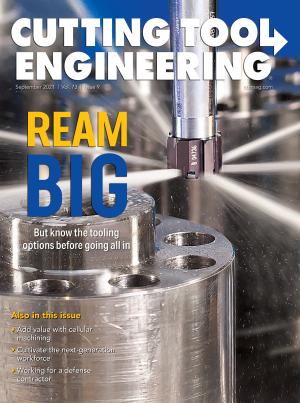The customer is king. To best serve him, JR Machine Inc. implemented work cells into its machining environment as part of a lean manufacturing initiative, said Tim Tumanic, CEO and president of the Shawano, Wisconsin, parts manufacturer.
Founded in 1992 with a focus on producing bushings and pins, JR Machine’s continuous improvement journey began a dozen years later, he said, when competition from Asian manufacturers heated up for commodity-type parts.
“We made the decision that how we are going to compete and actually thrive was by driving value on complex parts for the customer,” Tumanic said.
He said the parts that the company produces for a host of industries, including heavy machinery, hydraulics, energy, medical, defense and fire suppression, are not necessarily complex from a geometric standpoint but rather from a supply chain standpoint. Therefore, JR Machine provides complete supply chain services, such as post-machining services and procuring all types of workpiece materials, including cast and forged ones, he said.

JR Machine’s shop floor layout is shown. Image courtesy of JR Machine
During the initial downturn in activity caused by the pandemic, Tumanic said JR Machine earned an AS9100D certification for the aerospace industry. The manufacturer now machines a sizable amount of high-temperature superalloys.
“Aerospace alloys have been big for us and allowed us to get into some different markets,” he said. “We went after those types of customers and are now seeing the fruits of those efforts.”
A Common Platform
Although the industries that JR Machine serves are diverse, it machines parts from 25.4 mm to 254 mm (1" to 10") in diameter and up to 711.2 mm (28") long, leading them to be machined by a certain size of machine tool, Tumanic said.
“So we have used the DMG Mori NL 2500 platform as our choice (of) machine tool going forward,” he said.
With 12 work cells and plans for three or four new cells in the next year to 18 months as the company adds 929 sq. m (10,000 sq. ft.) to its approximate 3,252-sq.-m (35,000-sq.-ft.) facility, Tumanic said JR Machine takes a cellular approach to machine acquisitions.
“When we make a machine tool purchase,” he said, “we don’t look at (it as if) we are buying two machines. We are buying a cell.”
Typically, Tumanic said, each cell has two machines with live tooling, which reduces lead time.
“They are multitaskers,” he said, “so you can complete operations all in one cell. One of the big things in this cellular arrangement and buying machines with live tooling is that they are not only turning centers — they are also machining centers. A part doesn’t have to sit in queue waiting for a machining center.”
In addition to machining, Tumanic said the cells can be configured to add further value to parts. Options include marking, cleaning, packaging, labeling and assembly.

Tim Tumanic is CEO and president of JR Machine. Image courtesy of JR Machine
“We can easily put seals on the part, snap rings, pins,” he said.
To reduce motion waste, Tumanic said the cells have a computer station to enable workers to have everything they need to operate each cell. For example, they can download programs from the server, print labels with all the required information, refer to the employee handbook and even request time off.
“They can do everything right from the cell,” he said.
Because customers don’t appreciate the cost associated with long setup times, Tumanic said the shop continually drills down on those times. One way is by making sure the necessary cutting tools for a job are always available and nearby. To help with that effort, JR Machine contracts with Badger Mill Supply Corp. in Oshkosh, Wisconsin, to manage its tooling inventory system.
In addition, JR Machine purchased custom shop benches and cabinets, which he said are identical from cell to cell. Each drawer contains specific tools needed to operate a cell, and each arrangement is universal throughout all cells to minimize the time needed to locate, for instance, a particular wrench. He said time spent searching for an item is the biggest time waste for setup.
A Balancing Act
Although the DMG Mori NL 2500 is JR Machine’s primary machine platform, Tumanic said the shop replaced two NLX 2500 turning centers with two NZX 2000 turning centers when the older machines with one spindle and one turret hit their replacement age. The replacements have dual spindles, three separate turret stations with live tooling and a gantry loader, and the machines turn parts up to 320.04 mm (12.6") in diameter and up to 810.26 mm (31.9") long.
Having a third turret helps balance the processing times when cellular machining, which he emphasized is critical to maximize throughput. For example, if one spindle produces the needed features on a part in three minutes but the other spindle takes five minutes to perform machining, the cycle time is five minutes. To bring the cycle time closer to three minutes, the third turret is used to reduce the time on the spindle with the longer cycle.
For the other cells, Tumanic said balancing is performed with pre-process engineering.
JR Machine employs 35 people to handle two shifts Monday through Friday, he said, while only a couple of workers are on hand for lights-out machining during the weekend shift.
“We typically run lower-risk parts in the lights-out over the weekend,” Tumanic said.

CNC Technician Gage Skalitsky installs plugs to keep internal bores clean prior to machining in a work cell. Image courtesy of JR Machine
To help staff the shop, he said JR Machine invests in the machine tool programs at area high schools. Those programs expose students to machining career opportunities and enable interested students to work at the company during the summer. After graduation, prospective workers are offered full-time employment. They shadow a senior operator for 90 days as part of the onboarding process, and then they enter a two-year training program.
In addition to wages, which Tumanic said progress quickly after training is completed, employees are rewarded financially on a quarterly basis for improvements made over the baseline. Improvements might come from reducing tooling supplies or cycle times, as well as other variable expenses.
“We are transparent with the employees as far as financial metrics,” he said.
With the economy gaining steam, however, JR Machine also seeks workers who don’t come from local high schools. Its website, for example, advertises positions for CNC machine operators with a $2,500 sign-on bonus after a 90-day probationary period.
Tumanic said a move to cellular machining starts with identifying the part mix that best lends itself to such an arrangement. JR Machine developed a part matrix in a Microsoft Excel spreadsheet to characterize part features and the opportunities for increasing productivity with work cells.
“At the onset,” he said, “you want to see the parts you can put through a work cell. Later on, as you get more used to it and you drive that continuous improvement culture, pretty much everything can go through it.”
Nonetheless, there is no finish line when it comes to cellular machining.
“We just keep refining it, making it better, making it better, making it better,” Tumanic said. “It’s a continuous improvement journey. It never stops.”
For more information about JR Machine, call 715-526-5970 or visit www.jrmachine.com.
Related Glossary Terms
- alloys
alloys
Substances having metallic properties and being composed of two or more chemical elements of which at least one is a metal.
- centers
centers
Cone-shaped pins that support a workpiece by one or two ends during machining. The centers fit into holes drilled in the workpiece ends. Centers that turn with the workpiece are called “live” centers; those that do not are called “dead” centers.
- computer numerical control ( CNC)
computer numerical control ( CNC)
Microprocessor-based controller dedicated to a machine tool that permits the creation or modification of parts. Programmed numerical control activates the machine’s servos and spindle drives and controls the various machining operations. See DNC, direct numerical control; NC, numerical control.
- lean manufacturing
lean manufacturing
Companywide culture of continuous improvement, waste reduction and minimal inventory as practiced by individuals in every aspect of the business.
- machining center
machining center
CNC machine tool capable of drilling, reaming, tapping, milling and boring. Normally comes with an automatic toolchanger. See automatic toolchanger.
- milling machine ( mill)
milling machine ( mill)
Runs endmills and arbor-mounted milling cutters. Features include a head with a spindle that drives the cutters; a column, knee and table that provide motion in the three Cartesian axes; and a base that supports the components and houses the cutting-fluid pump and reservoir. The work is mounted on the table and fed into the rotating cutter or endmill to accomplish the milling steps; vertical milling machines also feed endmills into the work by means of a spindle-mounted quill. Models range from small manual machines to big bed-type and duplex mills. All take one of three basic forms: vertical, horizontal or convertible horizontal/vertical. Vertical machines may be knee-type (the table is mounted on a knee that can be elevated) or bed-type (the table is securely supported and only moves horizontally). In general, horizontal machines are bigger and more powerful, while vertical machines are lighter but more versatile and easier to set up and operate.
- superalloys
superalloys
Tough, difficult-to-machine alloys; includes Hastelloy, Inconel and Monel. Many are nickel-base metals.
- turning
turning
Workpiece is held in a chuck, mounted on a face plate or secured between centers and rotated while a cutting tool, normally a single-point tool, is fed into it along its periphery or across its end or face. Takes the form of straight turning (cutting along the periphery of the workpiece); taper turning (creating a taper); step turning (turning different-size diameters on the same work); chamfering (beveling an edge or shoulder); facing (cutting on an end); turning threads (usually external but can be internal); roughing (high-volume metal removal); and finishing (final light cuts). Performed on lathes, turning centers, chucking machines, automatic screw machines and similar machines.


